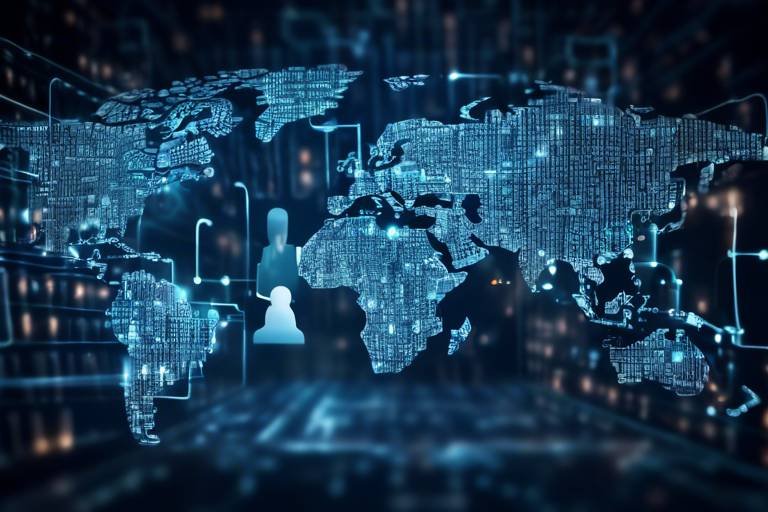Essential Elements of a Cybersecurity Strategy
In today's digital age, the importance of a robust cybersecurity strategy cannot be overstated. Organizations face an ever-evolving landscape of cyber threats that can compromise sensitive data, disrupt operations, and damage reputations. To effectively protect against these risks, it is crucial to understand and implement the essential elements of a cybersecurity strategy. These elements serve as the backbone of an organization's defense mechanism, ensuring that all bases are covered when it comes to safeguarding information and maintaining operational integrity.
Imagine your organization as a fortress. Just like a fortress needs strong walls, vigilant guards, and a clear plan for emergencies, your cybersecurity strategy must include several key components to keep potential threats at bay. From assessing risks to training employees and implementing strong security measures, each element plays a critical role in creating a secure environment. So, what are these essential elements, and how do they work together to create a comprehensive cybersecurity strategy? Let's dive in!
Conducting a thorough risk assessment is vital for identifying potential threats and vulnerabilities within an organization. This process involves evaluating the various risks that could impact your business operations, such as data breaches, malware attacks, and insider threats. By understanding these risks, organizations can develop targeted strategies for risk management and mitigation. Think of it like a health check-up for your cybersecurity posture; it helps you identify weaknesses and take proactive measures to strengthen your defenses.
Establishing comprehensive security policies is another cornerstone of an effective cybersecurity strategy. These policies define the protocols and procedures that govern how your organization approaches cybersecurity. They ensure that all employees understand their roles and responsibilities in maintaining security. Without clear policies, it’s like sailing a ship without a compass; you may drift off course without realizing it. Security policies should be regularly updated to reflect new threats and changes in technology, ensuring that your organization remains vigilant.
Regular employee training programs are essential for raising awareness about cybersecurity threats. Employees are often the first line of defense against cyber attacks, and equipping them with knowledge about safe practices can significantly reduce risks. Training should cover topics such as recognizing phishing attempts, using strong passwords, and reporting suspicious activities. Just like a fire drill prepares employees for emergencies, cybersecurity training empowers them to respond effectively to potential security incidents.
Having an effective incident response plan is crucial for minimizing damage in the event of a cybersecurity breach. This plan outlines the steps to be taken when a security incident occurs, ensuring a swift and organized response. Think of it as a fire escape plan; when the alarm goes off, you need to know exactly what to do to ensure everyone's safety. An incident response plan should include communication protocols, roles and responsibilities, and recovery procedures to help your organization bounce back quickly.
Implementing data encryption is a critical measure to protect sensitive information. Encryption converts data into a secure format, making it unreadable to unauthorized users. This is akin to locking your valuables in a safe; even if someone breaks in, they won't be able to access what's inside without the key. By encrypting data, organizations can significantly reduce the risk of data breaches and ensure compliance with regulations that mandate the protection of personal information.
Strengthening network security is essential for defending against unauthorized access and ensuring the integrity of your organization’s data. This involves deploying firewalls, intrusion detection systems, and secure configurations. Think of your network as a city; you wouldn't leave the gates wide open for intruders. A multi-layered approach to network security helps create barriers that protect your digital assets from malicious actors.
Conducting regular cybersecurity audits is crucial for assessing your organization’s security posture. These audits help identify vulnerabilities and ensure compliance with industry standards and regulations. Just as you would routinely check your car for maintenance, regular audits allow organizations to stay ahead of potential threats and continuously improve their security measures. They provide a clear picture of where you stand and what needs to be addressed.
As organizations increasingly rely on external vendors, managing third-party risks has become crucial. Establishing protocols to evaluate and monitor third-party security practices can mitigate potential vulnerabilities. It’s like inviting guests into your home; you want to ensure they respect your space and follow your rules. By vetting third-party vendors and establishing clear security expectations, organizations can safeguard their data from potential breaches originating from external sources.
Finally, implementing continuous monitoring allows organizations to detect and respond to threats in real-time. This proactive approach ensures that security measures remain effective against evolving cyber threats. Imagine having a 24/7 security guard watching over your property; continuous monitoring provides that level of vigilance. By leveraging advanced tools and technologies, organizations can quickly identify suspicious activities and mitigate risks before they escalate into significant problems.
- What is the most important element of a cybersecurity strategy?
While all elements are crucial, conducting a thorough risk assessment is foundational as it informs all other components. - How often should employee training be conducted?
Regular training is recommended at least once a year, with updates as needed to address new threats. - What should be included in an incident response plan?
An incident response plan should include roles and responsibilities, communication protocols, and recovery procedures.

Risk Assessment
This article explores the critical components necessary for developing an effective cybersecurity strategy to protect organizations from evolving threats and vulnerabilities in the digital landscape.
Conducting a thorough is vital for identifying potential threats and vulnerabilities within an organization. Think of it as a health check-up for your digital infrastructure. Just like you wouldn't ignore a persistent cough, ignoring cybersecurity risks can lead to severe consequences. A risk assessment allows you to pinpoint where your organization stands in terms of security, enabling the development of targeted strategies for risk management and mitigation.
During the risk assessment process, organizations should focus on several key areas:
- Identifying Assets: Recognizing what data and systems are critical to your operations is the first step. This includes everything from customer information to proprietary software.
- Evaluating Threats: Understanding the landscape of potential threats—be it hackers, malware, or insider threats—helps in crafting a robust defense.
- Assessing Vulnerabilities: Every organization has weaknesses. Identifying these vulnerabilities is crucial in determining how they can be exploited by threats.
- Analyzing Impact: What would happen if a breach occurred? This analysis helps in prioritizing risks based on their potential impact on the business.
- Determining Likelihood: Assessing how likely each identified risk is to occur allows organizations to focus their resources effectively.
After identifying these elements, organizations can create a comprehensive risk management plan tailored to their specific needs. This plan should involve the following:
| Step | Description |
|---|---|
| 1. Risk Identification | Catalog all potential risks to your assets. |
| 2. Risk Analysis | Evaluate the potential impact and likelihood of each risk. |
| 3. Risk Prioritization | Rank risks based on their severity and likelihood. |
| 4. Risk Mitigation | Develop strategies to minimize or eliminate risks. |
| 5. Monitoring and Review | Continuously monitor risks and adjust strategies as necessary. |
It's essential to remember that risk assessment is not a one-time task but an ongoing process. As the digital landscape evolves, so do the threats. Regularly revisiting your risk assessment ensures that your organization remains vigilant and prepared. By taking the time to assess risks, you not only safeguard your assets but also enhance your organization's overall resilience against cyber threats.
Q: How often should a risk assessment be conducted?
A: It's recommended to conduct a risk assessment at least annually, or whenever significant changes occur within the organization, such as new technology implementation or changes in business operations.
Q: What tools can assist in conducting a risk assessment?
A: Various tools are available, including risk assessment software, vulnerability scanners, and frameworks like NIST or ISO 27001 that guide organizations in identifying and managing risks.
Q: Who should be involved in the risk assessment process?
A: A cross-functional team that includes IT, security, compliance, and business unit representatives should be involved to ensure a comprehensive assessment of risks.

Security Policies
This article explores the critical components necessary for developing an effective cybersecurity strategy to protect organizations from evolving threats and vulnerabilities in the digital landscape.
When it comes to cybersecurity, are the backbone of any effective strategy. Think of them as the rulebook that guides an organization's approach to safeguarding its digital assets. Without these policies, employees might as well be navigating a minefield blindfolded! Establishing comprehensive security policies is essential in defining the protocols and procedures that govern how an organization manages cybersecurity risks.
So, what exactly should these policies cover? Well, they need to address a variety of aspects, including but not limited to:
- Acceptable Use Policy (AUP): This outlines what employees can and cannot do with company resources, such as internet usage and handling sensitive data.
- Access Control Policy: This dictates who has access to what information, ensuring that only authorized personnel can view sensitive data.
- Incident Response Policy: This describes the steps to take when a security breach occurs, ensuring a swift and organized response.
- Data Protection Policy: This focuses on how to handle and protect sensitive information, including data retention and destruction practices.
Moreover, it's crucial that these policies are not just created and forgotten. They must be actively communicated to all employees. Regular training sessions can play a significant role in this, helping staff understand the importance of adhering to these rules. After all, a policy is only as strong as the people who are expected to follow it. Imagine trying to win a game without knowing the rules; it’s nearly impossible!
Furthermore, organizations should regularly review and update their security policies to adapt to the ever-changing cybersecurity landscape. New threats emerge daily, and policies that were effective last year might not cut it today. By conducting periodic reviews, businesses can ensure their policies are relevant and robust, providing a solid defense against potential breaches.
In conclusion, security policies are not just a checkbox on a compliance list; they are a vital component of a robust cybersecurity strategy. They set the tone for the organization's security culture and ensure that everyone is on the same page. By clearly defining roles, responsibilities, and expectations, organizations can empower their employees to act as the first line of defense against cyber threats.
- What is the purpose of security policies?
- Security policies serve to define the rules and guidelines for protecting an organization's information assets, ensuring that all employees understand their responsibilities in maintaining security.
- How often should security policies be reviewed?
- It’s advisable to review security policies at least annually or whenever there are significant changes in the organization or the threat landscape.
- Who is responsible for enforcing security policies?
- While every employee is responsible for following security policies, typically, the IT department or a designated security officer oversees enforcement and compliance.

Employee Training
In today's digital age, where cyber threats loom around every corner, is not just a checkbox on a compliance list; it’s a vital component of an effective cybersecurity strategy. Think of your employees as the first line of defense in a fortress. If they are well-trained and aware of the latest threats, they can act as vigilant sentinels, ready to spot and thwart potential breaches before they escalate into full-blown disasters.
Regular training programs should be designed to keep employees informed about the evolving landscape of cybersecurity threats. For instance, topics might include recognizing phishing attempts, understanding the importance of secure passwords, and knowing how to handle sensitive data. By fostering a culture of security awareness, organizations empower their staff to not only protect themselves but also to contribute to the overall security posture of the organization.
Moreover, training should not be a one-time event. Just as the digital landscape is constantly changing, so too should the training programs. Consider implementing a cybersecurity training calendar that includes:
- Quarterly workshops on emerging threats.
- Monthly newsletters with tips and best practices.
- Annual certifications to reinforce knowledge and skills.
To make training more engaging, organizations can utilize various formats such as interactive e-learning modules, live webinars, and even gamified training experiences. These methods not only enhance learning but also help to retain information better. After all, who doesn’t remember a fun game or a captivating story?
Additionally, it’s crucial to assess the effectiveness of training programs. Regular feedback sessions, quizzes, and practical assessments can help gauge employee understanding and retention of the material. This not only identifies knowledge gaps but also allows for the adjustment of training methods to better suit the needs of the workforce.
In conclusion, investing in is akin to investing in a robust security system for your home. You wouldn’t leave your front door unlocked, would you? Similarly, organizations must equip their employees with the knowledge and skills necessary to keep their digital assets secure. By fostering a culture of continuous learning and vigilance, businesses can create a formidable defense against cyber threats that are ever-evolving in nature.
Q1: How often should employee training be conducted?
A1: Employee training should be conducted regularly, with quarterly workshops, monthly updates, and annual certifications to ensure that staff are always informed about the latest threats and best practices.
Q2: What topics should be included in employee training?
A2: Training should cover recognizing phishing attempts, password security, data handling practices, and incident response procedures to equip employees with essential cybersecurity knowledge.
Q3: How can organizations measure the effectiveness of training?
A3: Organizations can measure effectiveness through feedback sessions, quizzes, and practical assessments to identify knowledge gaps and adjust training methods accordingly.

Incident Response Plan
This article explores the critical components necessary for developing an effective cybersecurity strategy to protect organizations from evolving threats and vulnerabilities in the digital landscape.
Conducting a thorough risk assessment is vital for identifying potential threats and vulnerabilities within an organization, enabling the development of targeted strategies for risk management and mitigation.
Establishing comprehensive security policies helps define the protocols and procedures that govern an organization’s approach to cybersecurity, ensuring all employees understand their roles and responsibilities in maintaining security.
Regular employee training programs are essential to raise awareness about cybersecurity threats, promote safe practices, and empower staff to recognize and respond to potential security incidents effectively.
When it comes to handling cybersecurity breaches, having a well-defined Incident Response Plan (IRP) is like having a fire extinguisher in a building—it's crucial to be prepared before the flames start. An effective IRP outlines the steps to be taken in the event of a cybersecurity incident, ensuring that the organization can respond swiftly and efficiently. This not only minimizes damage but also aids in the recovery process.
First and foremost, it’s important to assemble an incident response team (IRT) made up of key personnel from various departments such as IT, legal, and communications. This multidisciplinary approach ensures that all aspects of the incident are covered, from technical response to public relations. The team should be trained and ready to act at a moment’s notice.
The IRP should include the following critical components:
- Preparation: Establishing protocols and tools necessary for incident detection and response.
- Identification: Detecting and confirming the incident, including its scope and impact.
- Containment: Implementing measures to limit the damage and prevent further unauthorized access.
- Eradication: Removing the cause of the incident and ensuring vulnerabilities are addressed.
- Recovery: Restoring systems and data to normal operations while monitoring for any signs of weaknesses.
- Lessons Learned: Conducting a post-incident review to analyze what happened and how to improve future responses.
Moreover, regular drills and simulations of potential incidents can prepare the team for real-life scenarios. Think of it as a fire drill; the more you practice, the better you’ll perform when it truly matters. During these exercises, it’s essential to assess the effectiveness of the IRP and make adjustments as necessary.
In addition, communication during an incident is key. The IRP should include a communication strategy that outlines how information will be shared internally and externally. Transparency can go a long way in maintaining trust with clients and stakeholders, especially in a crisis.
Implementing data encryption protects sensitive information by converting it into a secure format, making it unreadable to unauthorized users and reducing the risk of data breaches.
Strengthening network security involves deploying firewalls, intrusion detection systems, and secure configurations to protect against unauthorized access and ensure the integrity of the organization’s data.
Conducting regular cybersecurity audits helps organizations assess their security posture, identify vulnerabilities, and ensure compliance with industry standards and regulations, leading to continuous improvement.
Managing third-party risks is crucial as organizations increasingly rely on external vendors; establishing protocols to evaluate and monitor third-party security practices can mitigate potential vulnerabilities.
Implementing continuous monitoring allows organizations to detect and respond to threats in real-time, ensuring that security measures remain effective against evolving cyber threats and minimizing potential damage.
1. What is an Incident Response Plan?
An Incident Response Plan (IRP) is a structured approach to addressing and managing the aftermath of a cybersecurity incident. It includes preparation, detection, response, and recovery processes.
2. Why is employee training important in cybersecurity?
Employee training is crucial because it equips staff with the knowledge to recognize and respond to potential security threats, reducing the risk of human error.
3. How often should an organization conduct cybersecurity audits?
Organizations should conduct cybersecurity audits at least annually, but more frequent assessments may be necessary depending on the organization's size and complexity.
4. What role does data encryption play in cybersecurity?
Data encryption protects sensitive information by converting it into a format that unauthorized users cannot read, thereby safeguarding it from breaches.

Data Encryption
This article explores the critical components necessary for developing an effective cybersecurity strategy to protect organizations from evolving threats and vulnerabilities in the digital landscape.
Conducting a thorough risk assessment is vital for identifying potential threats and vulnerabilities within an organization, enabling the development of targeted strategies for risk management and mitigation.
Establishing comprehensive security policies helps define the protocols and procedures that govern an organization’s approach to cybersecurity, ensuring all employees understand their roles and responsibilities in maintaining security.
Regular employee training programs are essential to raise awareness about cybersecurity threats, promote safe practices, and empower staff to recognize and respond to potential security incidents effectively.
An effective incident response plan outlines the steps to be taken in the event of a cybersecurity breach, ensuring a swift and organized response to minimize damage and recover quickly.
In today's digital world, where data breaches are increasingly common, acts as a formidable defense against unauthorized access. By converting sensitive information into a format that can only be read by those who possess the correct decryption key, organizations can significantly reduce the risk of data theft. Imagine locking your valuables in a safe; encryption serves as that safe, ensuring that only authorized personnel can access the contents.
Moreover, encryption is not just a one-time setup; it requires ongoing management and updates to stay effective. This is where the concept of encryption keys comes into play. These keys are like the combinations to your safe, and if they are compromised, the entire encryption process becomes futile. Therefore, organizations must implement strict policies for key management, including:
- Regularly rotating encryption keys to minimize the risk of exposure.
- Storing keys in secure locations separate from the encrypted data.
- Implementing access controls to ensure only authorized personnel can handle these keys.
Furthermore, data encryption can be categorized into two main types: symmetrical and asymmetrical encryption. Symmetrical encryption uses the same key for both encryption and decryption, making it fast but potentially less secure if the key is intercepted. On the other hand, asymmetrical encryption employs a pair of keys: a public key for encryption and a private key for decryption. This method enhances security but may be slower due to its complexity.
To illustrate the importance of data encryption, consider the following table that highlights the differences between symmetrical and asymmetrical encryption:
| Type | Key Usage | Speed | Security Level |
|---|---|---|---|
| Symmetrical | Same key for encryption and decryption | Fast | Moderate |
| Asymmetrical | Public key for encryption, private key for decryption | Slower | High |
In conclusion, implementing robust data encryption practices is essential for safeguarding sensitive information. As cyber threats continue to evolve, organizations must prioritize encryption as a fundamental component of their cybersecurity strategy. Not only does it protect data at rest, but it also secures data in transit, ensuring that information remains confidential and integral throughout its lifecycle.
Conducting regular cybersecurity audits helps organizations assess their security posture, identify vulnerabilities, and ensure compliance with industry standards and regulations, leading to continuous improvement.
Managing third-party risks is crucial as organizations increasingly rely on external vendors; establishing protocols to evaluate and monitor third-party security practices can mitigate potential vulnerabilities.
Implementing continuous monitoring allows organizations to detect and respond to threats in real-time, ensuring that security measures remain effective against evolving cyber threats and minimizing potential damage.
- What is data encryption? Data encryption is the process of converting sensitive information into a secure format that can only be accessed by those with the correct decryption key.
- Why is data encryption important? It protects sensitive information from unauthorized access and reduces the risk of data breaches.
- What are the types of encryption? The two main types of encryption are symmetrical and asymmetrical encryption, each with its own strengths and weaknesses.
- How can organizations manage encryption keys? Organizations should regularly rotate keys, store them securely, and implement access controls to protect them.

Network Security
When it comes to safeguarding your organization’s digital assets, is not just an option; it's a necessity. Think of your network as a fortress. If the walls are weak, intruders can easily breach your defenses and wreak havoc. In today’s fast-paced digital landscape, where cyber threats are evolving at an alarming rate, it’s crucial to implement robust measures that shield your data from unauthorized access and potential breaches. But what exactly does effective network security entail?
At its core, network security involves a combination of hardware and software technologies designed to protect your network from intrusions, misuse, and other threats. This includes deploying firewalls, which act as the first line of defense against malicious traffic. Firewalls monitor incoming and outgoing traffic based on predetermined security rules, effectively filtering out harmful data packets. But that’s just the beginning. To truly fortify your network, you need to incorporate a multi-layered approach that includes:
- Intrusion Detection Systems (IDS): These systems continuously monitor your network for suspicious activity, alerting you to potential threats before they can cause significant damage.
- Secure Configurations: Ensuring that all devices on your network are configured securely is essential. This means disabling unnecessary services, changing default passwords, and applying security patches promptly.
- Virtual Private Networks (VPNs): VPNs encrypt data as it travels over the internet, creating a secure tunnel that protects sensitive information from prying eyes.
Moreover, it’s not just about installing the right tools; ongoing management and monitoring are crucial. Regularly updating your security protocols and conducting vulnerability assessments can help identify weak points in your network. It’s like regularly inspecting the walls of your fortress to ensure there are no cracks that could be exploited. Additionally, employing a zero-trust model—which requires verification for every user and device attempting to access resources—can significantly enhance your security posture.
To give you a clearer picture, here’s a simple table outlining the key components of network security:
| Component | Description |
|---|---|
| Firewalls | Monitors and filters incoming and outgoing network traffic. |
| Intrusion Detection Systems | Detects and responds to suspicious activities on the network. |
| VPNs | Encrypts data traveling over the internet, ensuring privacy. |
| Secure Configurations | Involves setting devices to their most secure state. |
| Regular Audits | Assessing security measures and identifying vulnerabilities. |
In conclusion, network security is an ongoing process that requires vigilance and adaptability. As cyber threats continue to evolve, so too must your defenses. By implementing a comprehensive network security strategy, you not only protect your organization’s sensitive data but also build trust with your clients and stakeholders. After all, in the world of cybersecurity, it’s better to be proactive than reactive. So, are you ready to fortify your digital fortress?
Q1: What is the most important aspect of network security?
A1: While all aspects of network security are important, having a robust firewall and regular monitoring can significantly reduce the risk of unauthorized access.
Q2: How often should I update my network security measures?
A2: Regularly updating your security measures is crucial. It’s recommended to conduct reviews and updates at least quarterly, or whenever new threats emerge.
Q3: What is a zero-trust model?
A3: The zero-trust model is a security framework that requires strict identity verification for every person and device trying to access resources on a private network, regardless of whether they are inside or outside the network perimeter.

Regular Audits
This article explores the critical components necessary for developing an effective cybersecurity strategy to protect organizations from evolving threats and vulnerabilities in the digital landscape.
Conducting a thorough risk assessment is vital for identifying potential threats and vulnerabilities within an organization, enabling the development of targeted strategies for risk management and mitigation.
Establishing comprehensive security policies helps define the protocols and procedures that govern an organization’s approach to cybersecurity, ensuring all employees understand their roles and responsibilities in maintaining security.
Regular employee training programs are essential to raise awareness about cybersecurity threats, promote safe practices, and empower staff to recognize and respond to potential security incidents effectively.
An effective incident response plan outlines the steps to be taken in the event of a cybersecurity breach, ensuring a swift and organized response to minimize damage and recover quickly.
Implementing data encryption protects sensitive information by converting it into a secure format, making it unreadable to unauthorized users and reducing the risk of data breaches.
Strengthening network security involves deploying firewalls, intrusion detection systems, and secure configurations to protect against unauthorized access and ensure the integrity of the organization’s data.
Conducting regular cybersecurity audits is like giving your organization a health check-up. Just as you wouldn’t skip your annual physical, you shouldn’t overlook the importance of auditing your cybersecurity measures. These audits serve as a critical tool for assessing your security posture and identifying vulnerabilities that could be exploited by cybercriminals.
During an audit, organizations can evaluate their existing security controls and ensure they are functioning as intended. This process typically involves:
- Reviewing security policies and procedures
- Assessing compliance with industry standards and regulations
- Identifying gaps in security measures
- Testing the effectiveness of security technologies
Regular audits also foster a culture of continuous improvement. By identifying weaknesses, organizations can take proactive steps to strengthen their defenses. Think of it as a cycle: you assess, you improve, and then you assess again. This cycle helps keep your cybersecurity strategy aligned with the ever-evolving threat landscape.
Moreover, audits can uncover areas where employee training may be lacking. If specific vulnerabilities are found repeatedly, it may indicate a need for enhanced training or awareness programs. By addressing these gaps, organizations can empower their employees to be the first line of defense against cyber threats.
Lastly, it’s essential to document the findings and actions taken from these audits. This documentation not only provides a roadmap for future improvements but also demonstrates due diligence in the eyes of stakeholders and regulatory bodies. In essence, regular audits are not just a checkbox on a compliance list; they are a vital component of a robust cybersecurity strategy.
Managing third-party risks is crucial as organizations increasingly rely on external vendors; establishing protocols to evaluate and monitor third-party security practices can mitigate potential vulnerabilities.
Implementing continuous monitoring allows organizations to detect and respond to threats in real-time, ensuring that security measures remain effective against evolving cyber threats and minimizing potential damage.
Q: Why are regular audits important for cybersecurity?
A: Regular audits help identify vulnerabilities, ensure compliance with regulations, and foster a culture of continuous improvement in cybersecurity practices.
Q: How often should cybersecurity audits be conducted?
A: It is recommended to conduct cybersecurity audits at least annually, or more frequently if there are significant changes to the organization's technology or threat landscape.
Q: What should be included in a cybersecurity audit?
A: A cybersecurity audit should include a review of security policies, compliance checks, vulnerability assessments, and an evaluation of employee training programs.

Third-Party Risk Management
This article explores the critical components necessary for developing an effective cybersecurity strategy to protect organizations from evolving threats and vulnerabilities in the digital landscape.
Conducting a thorough risk assessment is vital for identifying potential threats and vulnerabilities within an organization, enabling the development of targeted strategies for risk management and mitigation.
Establishing comprehensive security policies helps define the protocols and procedures that govern an organization’s approach to cybersecurity, ensuring all employees understand their roles and responsibilities in maintaining security.
Regular employee training programs are essential to raise awareness about cybersecurity threats, promote safe practices, and empower staff to recognize and respond to potential security incidents effectively.
An effective incident response plan outlines the steps to be taken in the event of a cybersecurity breach, ensuring a swift and organized response to minimize damage and recover quickly.
Implementing data encryption protects sensitive information by converting it into a secure format, making it unreadable to unauthorized users and reducing the risk of data breaches.
Strengthening network security involves deploying firewalls, intrusion detection systems, and secure configurations to protect against unauthorized access and ensure the integrity of the organization’s data.
Conducting regular cybersecurity audits helps organizations assess their security posture, identify vulnerabilities, and ensure compliance with industry standards and regulations, leading to continuous improvement.
In today's interconnected world, managing third-party risks is not just an option; it's a necessity. Organizations increasingly rely on external vendors for various services, from cloud storage to software development. However, this reliance introduces potential vulnerabilities that could compromise your security posture. Think of it like inviting someone into your home; you need to know who they are and what they bring with them.
To effectively manage these risks, organizations should establish a robust framework for evaluating and monitoring third-party security practices. This involves:
- Due Diligence: Before partnering with a vendor, conduct thorough background checks and assessments of their security measures.
- Contractual Obligations: Ensure that contracts include clear security requirements and responsibilities.
- Regular Assessments: Schedule periodic reviews of third-party security practices to ensure compliance with your standards.
By implementing these strategies, organizations can significantly reduce the risk associated with third-party vendors. It's important to remember that a single weak link in your supply chain can lead to significant security breaches, so vigilance is key.
Moreover, establishing a culture of security awareness that extends to third-party relationships can further enhance your overall cybersecurity strategy. Encourage open communication and collaboration with your vendors to foster a shared commitment to security.
In conclusion, third-party risk management is an ongoing process. It requires continuous evaluation and adaptation to the evolving landscape of cybersecurity threats. Organizations that prioritize this aspect of their strategy will not only protect themselves but also build trust with their clients and partners.
Implementing continuous monitoring allows organizations to detect and respond to threats in real-time, ensuring that security measures remain effective against evolving cyber threats and minimizing potential damage.
- What is third-party risk management?
Third-party risk management involves assessing and mitigating the risks associated with external vendors and partners that have access to your organization's data and systems. - Why is third-party risk management important?
It is crucial because external vendors can introduce vulnerabilities that may lead to data breaches or other security incidents, impacting your organization's overall security posture. - How often should I assess third-party vendors?
Regular assessments should be conducted, ideally at least annually, or whenever there are significant changes in the vendor's services or your organization's risk profile.

Continuous Monitoring
In today's fast-paced digital environment, has become a cornerstone of effective cybersecurity strategies. Think of it as having a vigilant guard stationed at the gates of your digital fortress, always on the lookout for potential threats. With cyber threats evolving at lightning speed, organizations must adopt a proactive approach to security rather than a reactive one. Continuous monitoring enables businesses to detect anomalies and respond to incidents in real-time, which is crucial for minimizing damage and maintaining the integrity of sensitive data.
Imagine trying to catch a thief in a crowded market. If you only look at your valuables once in a while, you might miss the moment when they strike. Similarly, continuous monitoring allows organizations to keep an eye on their networks, systems, and data around the clock. By utilizing advanced tools and technologies, companies can track user activities, analyze network traffic, and identify unusual patterns that could indicate a security breach.
To implement an effective continuous monitoring strategy, organizations typically use a combination of the following components:
- Automated Monitoring Tools: These tools can scan networks and systems for vulnerabilities, ensuring that any potential threats are flagged immediately.
- Real-time Alerts: Setting up alerts for suspicious activities allows IT teams to react swiftly to potential breaches.
- Behavioral Analytics: By analyzing user behavior, organizations can establish a baseline and detect deviations that may signal a security incident.
Moreover, the integration of artificial intelligence and machine learning into monitoring systems has revolutionized how organizations approach cybersecurity. These technologies can analyze vast amounts of data at incredible speeds, identifying threats that may go unnoticed by human analysts. This not only enhances the speed of detection but also reduces the likelihood of false positives, allowing teams to focus on genuine threats.
However, continuous monitoring is not just about technology; it also requires a cultural shift within the organization. Employees must be trained to understand the importance of security and how their actions can impact the overall safety of the organization. Regular training sessions and updates on security practices can empower staff to play an active role in maintaining security.
In summary, continuous monitoring is a vital element of a robust cybersecurity strategy. By staying vigilant and adopting the right tools and practices, organizations can significantly reduce their risk of falling victim to cyberattacks. The key is to remain proactive, adapting to new threats as they arise and ensuring that every layer of the organization is fortified against potential breaches.
Here are some common questions regarding continuous monitoring:
- What is continuous monitoring?
Continuous monitoring refers to the ongoing observation of an organization's systems and networks to detect threats in real-time and respond promptly. - Why is continuous monitoring important?
It allows organizations to identify and address security threats before they can cause significant damage, ensuring the safety of sensitive data. - What tools are used for continuous monitoring?
Organizations often use automated monitoring tools, intrusion detection systems, and behavioral analytics software to facilitate continuous monitoring. - How can employees contribute to continuous monitoring?
By being aware of security protocols and reporting suspicious activities, employees can play a crucial role in the organization's overall security posture.
Frequently Asked Questions
- What is a cybersecurity strategy?
A cybersecurity strategy is a comprehensive plan that outlines how an organization will protect its digital assets from cyber threats. It encompasses various elements, such as risk assessment, security policies, and employee training, to create a robust defense against potential attacks.
- Why is risk assessment important?
Risk assessment is crucial because it helps organizations identify potential threats and vulnerabilities. By understanding these risks, organizations can develop targeted strategies for risk management and mitigation, ensuring they are better prepared to handle any incidents that may arise.
- How often should employee training be conducted?
Employee training should be conducted regularly, ideally at least once a year, to keep staff updated on the latest cybersecurity threats and best practices. Frequent training sessions help reinforce safe behaviors and empower employees to recognize and respond effectively to security incidents.
- What should be included in an incident response plan?
An effective incident response plan should include clear steps to follow during a cybersecurity breach, roles and responsibilities of team members, communication protocols, and procedures for assessing damage and recovery. This ensures a swift and organized response to minimize impact.
- Why is data encryption necessary?
Data encryption is necessary because it protects sensitive information by converting it into a secure format that unauthorized users cannot read. This significantly reduces the risk of data breaches and ensures that even if data is intercepted, it remains protected.
- What measures can be taken to enhance network security?
To enhance network security, organizations can deploy firewalls, intrusion detection systems, and secure configurations. Regular updates and patches, along with access controls, also play a vital role in protecting against unauthorized access and ensuring data integrity.
- How often should cybersecurity audits be conducted?
Cybersecurity audits should be conducted regularly, typically at least once a year, to assess an organization’s security posture. These audits help identify vulnerabilities, ensure compliance with industry standards, and promote continuous improvement in security practices.
- What is third-party risk management?
Third-party risk management involves establishing protocols to evaluate and monitor the security practices of external vendors. As organizations increasingly rely on third parties, managing these risks is crucial to mitigate potential vulnerabilities that could compromise security.
- Why is continuous monitoring important?
Continuous monitoring is important because it allows organizations to detect and respond to threats in real-time. By keeping an eye on security measures and potential vulnerabilities, organizations can adapt quickly to evolving cyber threats and minimize potential damage.



















